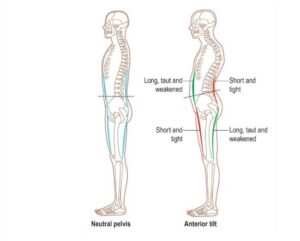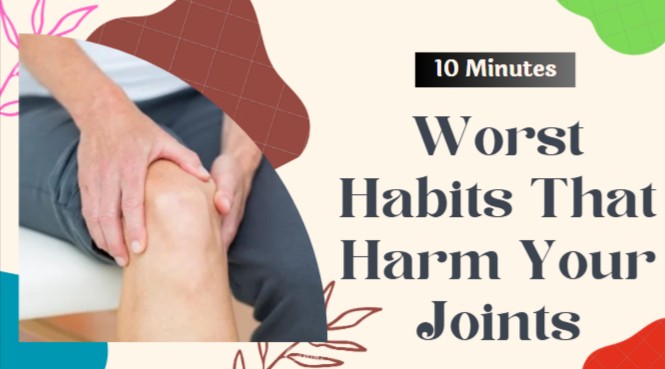Worst Habit That Harms Knees – Our knees are remarkable joints, bearing the weight of our bodies and allowing us to perform a wide range of movements, from walking and running to jumping and squatting.
However, these joints are also susceptible to wear and tear, and certain habits can accelerate their degeneration.
Here are some of the Worst Habit That Harms Knees –
1. Excessive Weight Gain

Carrying excess weight puts a significant strain on your knees, increasing the pressure on the joint cartilage. This can lead to early onset osteoarthritis, a painful condition characterized by the breakdown of cartilage. Maintaining a healthy weight is crucial for protecting your knees.
2. High-Impact Activities Without Proper Warm-up and Cool-down

Engaging in high-impact activities like running or jumping without proper preparation can put excessive stress on your knees. Warming up before and cooling down after exercise helps prepare your muscles and joints, reducing the risk of injury.
3. Improper Posture and Alignment

Poor posture, such as slouching or standing with your knees locked, can misalign your joints, leading to uneven wear and tear. Maintaining proper posture, with your knees slightly bent and your weight evenly distributed, helps protect your knees.
4. Lack of Flexibility and Strength

Tight muscles and weak ligaments around your knees can increase the risk of injury. Regular stretching and strengthening exercises help maintain joint flexibility and muscle strength, reducing the strain on your knees.
5. Wearing Inappropriate Footwear

Shoes that provide inadequate support or cushioning can increase the stress on your knees. Choosing shoes with proper arch support and cushioning for your activity level is essential for knee health.
6. Ignoring Knee Pain or Discomfort

If you experience knee pain or discomfort, don’t ignore it. Early intervention can prevent further damage. Seek medical attention to address the cause of the pain and receive appropriate treatment.
7. Repetitive Kneeling or Squatting

Repeatedly kneeling or squatting can put excessive strain on your knees, especially on the patellofemoral joint. If your job or activities require frequent kneeling or squatting, use protective knee pads and take breaks to rest your knees.
8. Climbing Stairs Without Railings

Climbing stairs without using railings can put additional strain on your knees. Whenever possible, use railings for support to reduce the impact on your knees.
9. Sitting for Extended Periods

Sitting for long periods without moving can tighten your muscles and make your knees stiff. Take regular breaks to walk around, stretch, and move your joints to maintain flexibility and reduce knee strain.
10. Neglecting Regular Exercise

Regular exercise, including low-impact activities like swimming or cycling, helps maintain joint health and muscle strength. Avoiding exercise can lead to muscle weakness and stiffness, increasing the risk of knee pain and injury.
Additional Tips for Knee Health:
1. Wear knee braces or supports: If you have ongoing knee pain or instability, consider wearing knee braces or supports. These can help stabilize the joint and reduce pain.
2. Maintain a healthy diet: Eating a balanced diet rich in fruits, vegetables, and whole grains can help reduce inflammation and promote joint health.
3. Avoid smoking: Smoking can damage cartilage and increase the risk of osteoarthritis. If you smoke, quit.
4. Get enough sleep: Sleep is essential for tissue repair and recovery. Aim for 7-8 hours of sleep each night.
5. Manage stress: Stress can contribute to muscle tension and pain. Find healthy ways to manage stress, such as yoga, meditation, or spending time in nature.
Precautions to Take When Exercising:
1. Start slowly and gradually increase intensity: Don’t overdo it, especially if you’re new to an activity. Gradually increase the intensity and duration of your workouts to avoid injury.
2. Choose low-impact activities: If you have knee pain, focus on low-impact activities like swimming, cycling, or water aerobics. These activities are less stressful on your knees than high-impact activities like running or jumping.
3. Warm up before and cool down after: Proper warm-up and cool-down are essential for preventing injuries. Warm up your muscles with light cardio and dynamic stretches before exercise, and cool down with static stretches and gentle movements afterward.
4. Listen to your body: Don’t push yourself through pain. If you experience pain, stop the activity and rest.
5. Use proper form: Using proper form during exercise is crucial for protecting your knees. If you’re unsure about the form for a particular exercise, ask a certified personal trainer for guidance.
By following these tips and precautions, you can protect your knees from harm and enjoy an active lifestyle for years to come. Remember, your knees are precious joints that deserve your care and attention.
Avoiding these harmful habits and adopting healthy practices, you can protect your knees and maintain their functionality for years to come. Remember, your knees are precious joints that deserve your care and attention.
